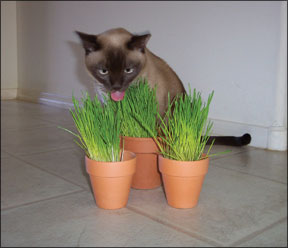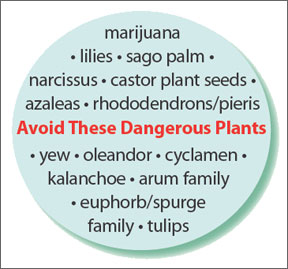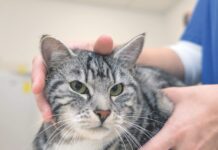Houseplants help add a natural look and feel to any home, but cat owners need to be very careful when selecting plants to spice up their dcor. Our feline friends are notorious for snacking on houseplants. According to ELise Christensen, DVM, animal behaviorist with NYC Veterinary Specialists in Manhattan, there may be several reasons for this: Bev Caldwell 288 Regardless of the reason for chewing on plants, it can be cause for serious concern if the cat ingests part of one thats toxic. The Most Dangerous Plants There are several fairly common houseplants that are harmful or even fatal for cats that eat them. Karyn Bischoff, DVM

Marijuana
can cause clinical signs similar to those in humans, including behavioral changes, stupor, dilated pupils, disorientation and even tremors, muscle twitching and coma. Although it is rarely lethal, it can be very dangerous if an owner is not forthcoming with the veterinarian about the cats having ingested it.Dr. Bischoff explains, “There was a tragic case in a ferret that had severe clinical signs and was euthanized before the owner felt comfortable enough to explain to the veterinarian that it had eaten a marijuana cigarette (joint).” It’s essential that a pet owner be honest with a veterinarian so that proper treatment can be performed. Prognosis is usually good.


Bev Caldwell
288
The
sago palm is often sold as a bonsai plant and is considered especially dangerous because of the nature of its effects when eaten. Early signs include vomiting and salivation; however, the cat may appear to recover only to go into liver failure several days later. It is therefore extremely important to take the cat to the veterinarian immediately if it ingests this plant.Lilies
are lethal to cats. A cat should be rushed immediately to the veterinarian upon ingestion of the plant, because it causes acute renal failure; symptoms may not be apparent for more than 12 hours after ingestion.Tulips and narcissus
contain an irritant that can cause gastrointestinal distress. Dr. Bischoff explains that the effects are usually self-limiting, but veterinary care should still be sought, especially if the cat has ingested a lot of the plant or has severe clinical signs.Azaleas, rhododendrons
and pieris are all related and cause severe diarrhea, vomiting and changes in heart rate. Clinical signs have even appeared in cats that ate chickens that ate the plant; the plants toxin is very potent. A veterinarian should be consulted if ingestion is suspected.Oleander
can rapidly become lethal according to Dr. Bischoff, and ingestion of this plant should be considered an emergency. It can cause diarrhea and vomiting, but then goes on to cause dangerous changes in heart rate. Unfortunately, some animals may die before they show clinical signs.Yew
is a very common landscaping plant in the United States; it is often used for hedges. Taxol, the chemotherapeutic agent, was isolated from this plant. However, it is taxine, a rapid-acting cardiotoxin, that causes the problem for animals. If ingestion is suspected, a veterinarian should be consulted immediately.The seeds of
castor plants contain the toxin ricin. If the seeds are swallowed whole, Dr. Bischoff explains, they are passed through the gastrointestinal tract without incident; in contrast, if the seeds are chewed or drilled for necklaces (the seeds are attractive and are sometimes used for jewelry), the toxin may be absorbed. Cats may be less likely to ingest the seeds than dogs. Symptoms include vomiting and diarrhea. Veterinary care should be sought because symptoms may become severe, and include gastrointestinal bleeding.Cyclamen
contains an irritant that causes diarrhea and vomiting but is not usually fatal. If large quantities of the plant have been ingested, however, it may affect the heart and nervous system. A veterinarian should still be consulted, in the very least to treat the diarrhea.Kalanchoe
also contains a cardiotoxin that may be lethal if enough of the plant is ingested. Milder symptoms include diarrhea that may last for several days; again, if enough is ingested, it may cause lethal changes in the heart rate. Of course, a veterinarian should be consulted if ingestion is suspected.The
arum family includes arum lilies, dieffenbachia, philodendron, peace lily, elephant ear and pothos. Dr. Bischoff describes the unique way in which the toxin in these plants works: “These plants contain pointy crystals called raphides in packets within the cells called idioblasts. They are sort of spring-loaded so that, when the animal bites down, the raphides are released into the oral cavity, where they penetrate the mucous membranes. The cells also contain histamine and similar chemicals to make the irritation caused by the crystals even more intense.” This causes severe pain and swelling. Additionally, swelling of the throat may cause difficulty in breathing; death is possible but rare. Veterinary care will help alleviate discomfort and ensure a positive outcome.The
euphorb or spurge family includes the crown of thorns, the candelabra cactus, the mother-of-millions and the poinsettia. The white sap they contain acts as an irritant. Symptoms usually include diarrhea, vomiting and possibly eye irritation. Most animals recover, but symptomatic care may be necessary in order to reduce discomfort. Clinical signs associated with poinsettia ingestion are usually mild. v


